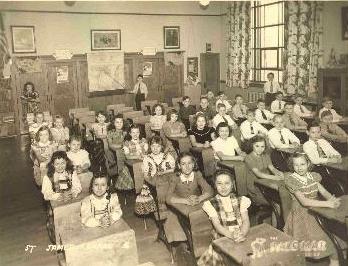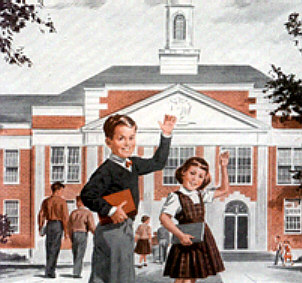
Figure 5.--This photograph appears to show a parchoical school classroom during the 1940s. The girls do not wear uniforms, but the boys appear to be wearing what has become the standard parochial school uniform.

By the late 1940s jeans (called dungarees at the time had become prevalent at many public schools. American children would normally wear leather shoes to school. Sneakers which appeared in the 1930s were not generally worn to school until the 1960s. Children in the early 20th century did not have the extensive wardrobes they have today. Children in urban areas dressed better than children in rural areas that might come to school in overalls and barefoot. Overalls were considered work clothes. Thus city boys would not generally have worn them to school.
One of the most significant development in American school wear was the gradual adoption of jeans as schoolwear. City boys did not generally wear jeans to school in the 1940s, although bibfront overalls were still worn in rural schools, especially in the South. This was declining, however, as economic conditions improved during the War. Only after knickers disappeared in the 1940s did jeans (we called then blue jeans) become standard school wear for city boys--but only in elementary schools. Many men wore them in the service during World War II an this gave a significant boost to their popularity upon returning home after the War. One notable observation is that boys always wore longpants jeans. Jean shorts were never worn to school. I do not think they were even made. Elementary children, especially the younger boys, did wear short pants to school in some areas, but never jean shorts.
Some interesting images exist of American elementary schools. Unfortunately it is not always clear if the children pictured are wearing their ordinary clothes or got dressed up for the camera. Many teachers would have incouraged the children to dress nicely if they were to have known a class photograph was to be taken.
On this page is a picture of St. James School in the 1940s--presumably a parochial school. The person standing at the left is probably a pupil and not the teacher. It is likely that a nun would have been teaching a parochial school in the 1940s. Nuns are much less common today and there is many more lay staff in modern parochial schools. The class room shows the standard arrangement, with the desks in straight rows facing the front. Of course there is a flag for the compulsory morning pledge of allegiance. (In British, New Zealand, Australian, and many other countries, a flag in the classroom is rare.) The children are separated with boys and girls on different sides. The girls do not wear a uniform, but all wear very proper dresses--no pants or shorts for girls in the 1940s. The boys all wear white or solid color shirts, ties, and dark pants. You can not tell if they wear knickers or slacks. Presumably they are not wearing dungarees. This looks very much like the basic uniform now commonly worn at pariochial schools, white or solid color shirts, ties, and dark pants.
A public school classroom would have looked very similarly, except the boys would have been less likely to wear white shirts and ties--unless they got dressed up for a photograph. Also flannel shirts and dungarees would have been standard boys' wear. Even the Scouts acknowledged changing fashion trends in the 1940s, first the Scouts and then even the Cubs.

Figure 6.--This idealized drawing shows how parents and teachers would have liked American children to wear to school. This is how girls did dress in the 1940s and 50s, but boys rarely wore ties. |
Boys in the South, because of the climate, were more likely to wear short pants than boys going to northern school. This varied widely as boys even in Southern schools mostly wore long pants. Usually iy was the younger boys wearing shorts. All the boys in this class at a southern school wore short pants--except for one boy wearing knickers. None of the boys wear kneesocks, so common in the 1930s.
Related Links: Careful this will exit you from the Boys'
Historical Clothing web site, but both sites are highly recommended.
Apertures Press International Project: Pictures at schools in different countries and a book on British schools
Apertures Press New Zealand book: New E-book on New Zealand schools in progress
School Uniform Web SiteInformative review of British school uniforms with some excellent photographs
Boys' Preparatory SchoolsLovely photographic essay of British preparatory schools during the 1980s containing over 200 color and black and white photographs.
Related Chronolgy Pages in the Boys' Historical Web Site
[Main Chronology Page]
[The 1900s]
[The 1910s]
[The 1920s]
[The 1930s]
[The 1940s]
[The 1950s]
[The 1960s]
[The 1970s]
[The 1980s]
[The 1990s]
[The 2000s]
Navigate the Relate Boys Historical Clothing Style Pages
[Main country page]
[Long pants suits]
[Short pants suits]
[Lederhosen]
[Kneesocks]
[Eton suits]
[Jacket and trousers]
[Blazer
[School sandals]
